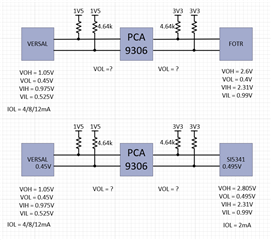I am planning on using a PCA9306 between an FPGA (master) and a two different slave devices.
Would you be able to walk through what the the VOL's be on both sides of the PCA9306? I guess what I am having a hard time is with the VOL from the devices are tested the high IOL's, more than what the pullup resistors would provide. Of course this is worse case, so my expectation is that the VOL would be must lower because the pullups are in the kohm range. The FOTR device does not specify the IOL for the given VOL.
Thanks


